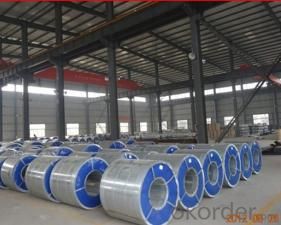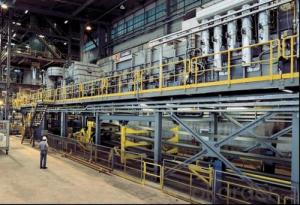Hot Rolled Steel Coil (1250.1500.1800 mm)
- Loading Port:
- Tianjin
- Payment Terms:
- TT OR LC
- Min Order Qty:
- 25 m.t.
- Supply Capability:
- 10000 m.t./month
OKorder Service Pledge
OKorder Financial Service
You Might Also Like
Basic Info.
Model NO.:Wefsun
Surface Treatment:Coated
Certification:SGS
Technique:Hot Rolled
Standard:GB
Application:Ship Plate
Edge:Mill
Stock:Stock
Steel Grade:Q195
Product Name:Hot Rolled Steel Coil
Width:1000.1250mm
Export Markets:South America, Southeast Asia, Africa, Oceania, Eastern Asia
Additional Info.
Trademark:Wefsun
Packing:Standard Export Seaworthy Packing
Standard:SGS, ISO BV
Origin:China
HS Code:72168500
Production Capacity
Product Description
1>Product Name:Hot Rolled Coil
2>ASTM,AISI,DIN,JIS,EN
3>Surface:BA,2B,No.1,No.4
4>Thickness:0.1-50mm
5>Width:1m,1.22m,1.5m or others
6>We have professional and strictly producing control system on hot rolled coil as below:
7 Before Formed Coil :
Assurance of compliance
Review of Sub-vendor ; quality plan ;
Review of samples certification (MTC)
Chemical analysis
Tension &Mechanical tests
8 Features:
Q195~Q345 hot rolled plate has low chemical composition and high-intensity, i.e. C and Mn content lower than that of all similar products at the same intensity level in China, high-performance products can be produced with low chemical composition. The specific hot-rolled process as per carbon equivalent will help improve the precision of product size and bring about high hit rate. Goods can be delivered as steel plates, steel coils and slitting strips to meet different needs of users.
- Q: What are the common applications of stainless steel coils?
- Stainless steel coils have numerous applications in various industries due to their exceptional corrosion resistance, durability, and versatility. Some common applications include manufacturing of kitchen appliances, automotive parts, construction materials, medical instruments, chemical processing equipment, and electrical components. Additionally, stainless steel coils are widely used in the production of pipes, tubes, and fittings for various sectors such as oil and gas, food processing, pharmaceuticals, and water treatment.
- Q: How are steel coils used in the production of metal containers?
- Steel coils are used in the production of metal containers by being processed and formed into sheets, which are then shaped and welded to create the body and lids of the containers. The strength and durability of steel make it an ideal material for these containers, providing protection for goods during transportation and storage.
- Q: How are steel coils used in the production of electrical relays?
- Steel coils are used in the production of electrical relays as the electromagnetic core. When an electric current passes through the coil, it generates a magnetic field that attracts or repels the relay's contacts, allowing the relay to switch on or off and control the flow of electricity in various applications.
- Q: Can steel coils be coated with color-changing materials?
- Yes, steel coils can be coated with color-changing materials. These materials, commonly known as thermochromic or photochromic coatings, can change color based on temperature or exposure to light, respectively. The application of such coatings on steel coils can provide an aesthetically pleasing and dynamic visual effect, making them suitable for various applications like automotive, architectural, and consumer products.
- Q: I am a complete idiot when it comes to anything musical, so please forgive me if this is a stupid question. I bought my son his first guitar, acoustic and didnt realize until after I purchased it that it has steel strings. Can I have the strings changed from steel to nylon???
- Haha, You're too cute for me. Did you buy Alex the guitar? Just wait until your boys become the next Jonas Brothers :)
- Q: How does stainless steel soap work? I have read the detailed explanation on Wikipedia, but their desciption seems skeptical on the actual chemical process that may take place from using such an item. Is there an actual scientific explanation to how stainless steel soap is able to clean your hands, when it is only a piece of metal?
- Many metals have germicidal qualities. Silver is the strongest germicide of the metals, but a sterling silver bar of soap would be expensive and it would tarnish. The tarnish would actually not affect the silver's ability to kill bacteria, but it would look bad and the tarnish would turn your hands black, so people wouldn't want to use it. Many people even take silver internally in the form of Colloidal Silver, but Colloidal Silver is very controversial. Yes, it kills many bacteria, but it can also cause a person's skin to permanently turn blue...a condition called Argyria. Brass actually is a better germicide than stainless steel...but again this is a cosmetic problem. Brass tarnishes, so people wouldn't want to use it. Stainless steel is actually a very weak germicide, but even steel has some ability to kill germs. Stainless steel also removes fish odor. My son has a stainless steel bar that he takes along when he fishes to remove the fish smell from his hands. There's nothing magical about the bar...a stainless steel spatula would would just as well, but the bar is more convenient to carry. I'm not sure if this is scientific enough or not. -
- Q: Alright...Please tell me what I can and can't buy for Steel Legion in detail(Much Detail please)Ogryns.Las canons.The problem I'm having is that they don't have steel Legion Uniform..does it matter?1.I also heard that you can't use Commisar Yarrick.(So what could I use?)2.What are my Hq choices,Fast attack,Heavy Support,Elite etc.3.Steel Legion has a Commisar....(Do I buy one for each squad of Steel Legion or one?)Please in detail what should I buy...I don't have the codex yet but will soon!!4.I also heard that if I get Steel Legion I need a transport for everything?(Is this true?)5.Please be detail on what i can't and can buy!!(Please like HQ Squad leader,Sargent)
- here are a couple of things about the steel legion. you should have a lot of mechanized units, have chimaras for rvery squad if posible, artillery fire helps a hell of a lot. also sentinals and leman russes and hell hounds also help. if in apocolypse, use banblades and titans. storm trooper squads should be your base squadrons. put them in chimeras and get near the action, drop 'em off and rapid fire like CRAZY!!! the steel legion loves heavy weapons so remember to get some heavy weapons platforms. there favourite weapons are grenade and missle launchers. there is also an officer you can buy with a power sword with the steel legion look. steel legion are big xeno hunters. because commisar is a ork killer you should be allowed to field him. ratling/ sniper squads also help and if you can get a vindicare assassin that is very useful.
- Q: How are steel coils used in the manufacturing of automotive doors?
- Steel coils are used in the manufacturing of automotive doors as they serve as the primary raw material for forming the door panels. These coils are processed through various manufacturing techniques such as stamping, cutting, and bending to shape the door panels. The strong and durable nature of steel makes it an ideal material for automotive doors, providing structural integrity and protection to the vehicle.
- Q: is it much difference between 1095 and 1080,,,1065,,,1060 or even 1045 steel?please help and thanks!
- Carbon Steel Swords
- Q: I'm trying to make a corset but I can't find any steel boning in my area. Any clue as to what materials I could buy to to make my own bones, or anything that would work similarly?I know there are places to buy it online, but the cost of shipping makes it barely seem worth it.
- Hi, buy the original bones. They are designed to corset's load. If you use any substitute material it could break and it could be cause of injuries. Use google for link to corset's bones suppliers. Look on:
Send your message to us
Hot Rolled Steel Coil (1250.1500.1800 mm)
- Loading Port:
- Tianjin
- Payment Terms:
- TT OR LC
- Min Order Qty:
- 25 m.t.
- Supply Capability:
- 10000 m.t./month
OKorder Service Pledge
OKorder Financial Service
Similar products
Hot products
Hot Searches
Related keywords


























